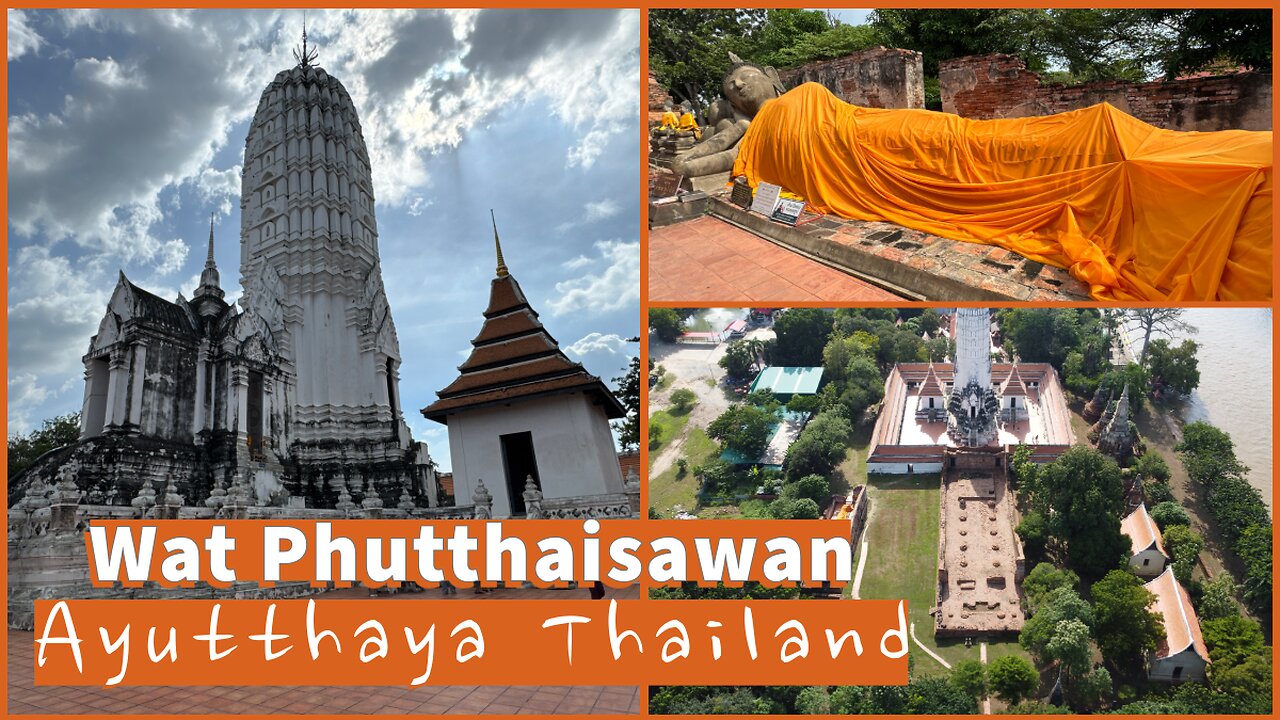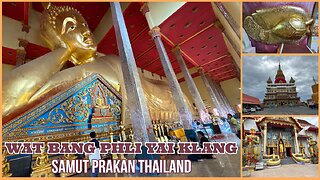Premium Only Content

Wat Phutthaisawan วัดพุทไธสวรรย์ - Built in 1353 With Drone Footage - Ayutthaya Thailand 2024
Wat Phutthaisawan or the Monastery of Buddhist Kingship is located on the south bank of the Chao Phraya River.
The temple was built in 1353 by King Ramathibodi I at the royal residence of "Wiang Lek", the site where he first settled before establishing Ayutthaya as the capital city in 1350.
The temple was constructed after his elder brother (the ruler of Suphan) defeated the Khmers and brought them back under the control of Ayutthaya in 1352.
The temple was likely built by the large number of enslaved Khmer inhabitants forcibly removed from Angkor to Ayutthaya at that time. The monastery was one of the first temples constructed and had a preaching hall and a great holy reliquary.
The old temple complex was enclosed by an outer wall measuring 192 meters in length and 92 meters in width. The vihara has its entry to the east and measures 48 meters in length and 16 meters in width. The main Khmer-style prang is surrounded by a square cloister.
The prang, representing the cosmic Mount Meru, is located in the middle of the ancient compound and is built on an indented pedestal protruding towards the north and south, resulting in a wing-like formation, which was characteristic for prangs of the early Ayutthaya period.
The statue of King U-Thong
Within the large prang was an image of King Ramathibodi I (King U-Thong). In 1784, in the reign of King Rama I, Prince Thepphonphak went to Ayutthaya to restore the elephant kraal and found the figure. He reported this to the king who decided to move the image to Bangkok. Later the figure was re-casted as a Buddha image, gilded with silver and moved to the Phra Nak Hall.
King Rama IV placed the image at the Prasat Phra Thep Bidorn (the Royal Pantheon - The Shrine of
the celestial Ancestors) in Wat Phra Kaeo in Bangkok. Local people believe that the spirit of Ramathibodi I still resides here.
South of the vihara is another smaller vihara with a reclining Buddha. Within the outer wall there are a number of chedi rai (small chedis) and small monastic structures.
The temple has been frequently restored throughout the Ayutthaya period. New constructions include the chedis in row, some of which were built during the Middle Ayutthaya Period.
Outside the boundary wall
The monastic quarters are situated west of the old site. On site is a two-story building called the Tamnak Phra Phutthakosajarn Hall (the residential building of Somdet Phra Phutthakosajarn), which served as a model for the Jim Thompson's silk shop in Bangkok. It was constructed together with its mural paintings in the Late Ayutthaya
Period.
The base of the building, curved like the hull of a Chinese junk, is classic for this period. The interior of the hall is highlighted with murals depicting the ten Jatakas (reincarnations of the Budddha - The Pali canonical book of Theravada Buddhism comprises 547 poems concerning the previous births of the Buddha) and the Somdet Phra Phutthakosajarn's pilgrimage to the Footprint of Lord Buddha in Ceylon. These murals are very faded but still visible after all of these years.
This temple has so much history and was a lot of fun to explore.
Enjoy the video!
You can also see my videos on Rumble, Bitchute, Odysee and Subscribe Star. If you have any questions or comments and wish to contact me directly I can be reached by email at endlessjourneytravels@gmail.com
https://www.bitchute.com/channel/pYUe8EgYcUMc/
https://odysee.com/$/latest/@EndlessJourney
https://rumble.com/c/EndlessJourney
https://www.subscribestar.com/endless-journey
Follow me on Twitter @AEndlessJourney
#endlessjourney
#travel
#thailand
-
 22:37
22:37
Endless Journey
7 days agoWat Bang Phli Yai Klang 53 Meter Reclining Buddha You Can Climb Inside - Samut Prakan Thailand 2024
111 -
 11:45:14
11:45:14
Right Side Broadcasting Network
9 days agoLIVE REPLAY: TPUSA's America Fest Conference: Day Three - 12/21/24
265K26 -
 12:19
12:19
Tundra Tactical
10 hours ago $9.70 earnedDaniel Penny Beats Charges in NYC Subway Killing
40.4K6 -
 29:53
29:53
MYLUNCHBREAK CHANNEL PAGE
1 day agoUnder The Necropolis - Pt 1
92.9K45 -
 2:00:10
2:00:10
Bare Knuckle Fighting Championship
3 days agoCountdown to BKFC on DAZN HOLLYWOOD & FREE LIVE FIGHTS!
47.4K3 -
 2:53:01
2:53:01
Jewels Jones Live ®
1 day agoA MAGA-NIFICENT YEAR | A Political Rendezvous - Ep. 103
111K29 -
 29:54
29:54
Michael Franzese
13 hours agoCan Trump accomplish everything he promised? Piers Morgan Article Breakdown
111K49 -
 2:08:19
2:08:19
Tactical Advisor
17 hours agoThe Vault Room Podcast 006 | Farwell 2024 New Plans for 2025
183K11 -
 34:12
34:12
inspirePlay
1 day ago $5.65 earned🏆 The Grid Championship 2024 – Cass Meyer vs. Kelly Rudney | Epic Battle for Long Drive Glory!
87.2K8 -
 17:50
17:50
BlackDiamondGunsandGear
15 hours ago $2.98 earnedTeach Me How to Build an AR-15
61.4K6